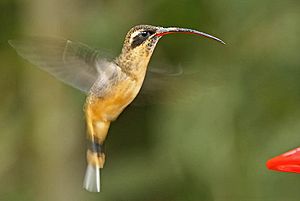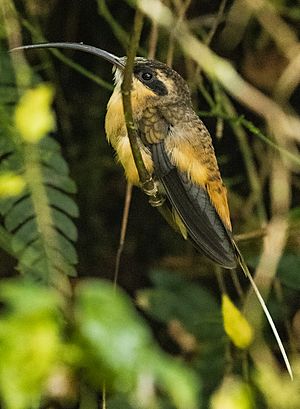Tawny-bellied hermit facts for kids
Quick facts for kids Tawny-bellied hermit |
|
|---|---|
 |
|
| Conservation status | |
| Scientific classification | |
| Genus: |
Phaethornis
|
| Species: |
syrmatophorus
|
 |
|
The tawny-bellied hermit is a beautiful type of hummingbird. It belongs to the Trochilidae family, which is the hummingbird family. You can find this special bird living in countries like Colombia, Ecuador, and Peru in South America. Its scientific name is Phaethornis syrmatophorus.
Contents
About This Hummingbird
Different Kinds of Tawny-bellied Hermits
Scientists have identified two main types, or subspecies, of the tawny-bellied hermit. These are P. s. syrmatophorus and P. s. columbianus. The first one was named by John Gould in 1852, and the second by Adolphe Boucard in 1891. Sometimes, birds from different areas can look a little different, even if they are the same species.
What Does It Look Like?
The tawny-bellied hermit is a medium-sized hummingbird. It is about 14 cm (5.5 in) long, which is roughly the length of your hand. It weighs between 5 to 7 g (0.18 to 0.25 oz), which is lighter than a single grape!
Its back is olive green. Male birds have reddish-orange feathers under their tails. The two central tail feathers are long and white. The other tail feathers are dark with bright orange tips.
The P. s. syrmatophorus subspecies has an orange throat, belly, and under the tail. However, the P. s. columbianus subspecies has a dark brown throat and chest. Both male and female tawny-bellied hermits have a bill that curves downwards. The female's bill is usually more curved than the male's.
Where Does It Live?
The tawny-bellied hermit lives in the Andes Mountains in South America.
- The P. s. syrmatophorus subspecies is found in the western parts of the Andes in Colombia. It also lives south through Ecuador to western Loja Province.
- The P. s. columbianus subspecies lives in the central and eastern Andes of Colombia. It also ranges south through Ecuador to northern Peru.
This hummingbird mainly lives in the lower parts of wet montane forests. You can also find it at the edges of forests or in thick secondary forests, which are forests that have grown back after being cut down. It usually lives at elevations between 1,000 and 2,300 m (3,300 and 7,500 ft) high. Sometimes, it can be seen as low as 750 m (2,500 ft) or as high as 3,100 m (10,000 ft).
Behavior and Life
Movement
Scientists believe that the tawny-bellied hermit does not travel far. It likely stays in the same area for its whole life.
What Does It Eat?
Like many other hermit hummingbirds, the tawny-bellied hermit is a "trap-line" feeder. This means it visits a regular path of many different flowering plants to drink their nectar. It also eats small arthropods, which are tiny insects and spiders.
Reproduction
The exact breeding times for the tawny-bellied hermit are not fully known. However, it seems they might breed between March and August, and possibly also in December.
The nest of this hummingbird is shaped like a cone. It is made from leaves and plant fibers. The bird uses spider silk to hold the nest together. The nest hangs from the tip of a drooping leaf. Female tawny-bellled hermits usually lay two eggs at a time.
What Does It Sound Like?
The song of the tawny-bellied hermit is a continuous series of high-pitched calls. They sound almost like an insect buzzing, often described as "tsi" calls. Several male hummingbirds often gather in a special area called a lek to sing together. This helps them attract mates. The bird also makes flight calls, which sound like an "upslurred 'peeet!'" or a soft "stip."
Conservation Status
The IUCN (International Union for Conservation of Nature) has evaluated the tawny-bellied hermit. They have listed it as a species of "Least Concern." This means that, for now, it is not considered to be in danger of disappearing.
However, the total number of these birds is not known. Scientists believe their population might be decreasing. Even though they live in some protected areas, losing their natural habitat (the places they live) could become a serious problem for them in the future.
See also
 In Spanish: Ermitaño leonado para niños
In Spanish: Ermitaño leonado para niños



